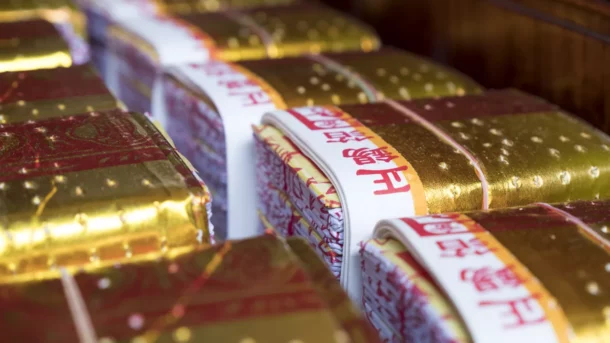Invention of paper money

Paper money was an invention of the Song Dynasty in China in the 11th century AD, nearly 20 centuries after the earliest known use of metal coins. While paper money was certainly easier to carry in large quantities, using paper money had its risks: counterfeiting and inflation.
First money
The earliest known form of money also comes from China: a cast copper coin from the 11th century BC that was found in a Shang Dynasty tomb in China. Metal coins, made from copper, silver, gold or other metals, were used throughout the world as units of trade and value. They have the advantages of being durable, difficult to counterfeit, and having intrinsic value. Big drawback? If there are too many of them, they become heavy.
However, for a couple of thousand years after the coins were buried in this Shang tomb, merchants, traders and buyers in China had to put up with carrying the coins or directly exchanging goods for other goods. Copper coins had square holes in the middle so they could be carried on a string. For large transactions, traders calculated the price as the number of coin chains. It was a workable but cumbersome system at best.
Paper money takes the pressure off
However, during the Tang Dynasty (618–907 AD), merchants began leaving these heavy bundles of coins with a trusted agent, who would write down on a piece of paper how much money the merchant had on deposit. The paper, a kind of promissory note, could then be exchanged for goods, and the seller could go to the agent and redeem the promissory note for a bundle of coins. The resumption of trade along the Silk Road greatly simplified horse-drawn transportation. However, these private bills were still not real paper money.
In the early Song Dynasty (960–1279 CE), the government licensed special deposit shops where people could deposit their coins and receive banknotes. In the 1100s, Song authorities decided to take direct control of this system by issuing the world’s first true government-issued paper money. This money was called jiaozi.
Jiaozi to the song
Song established factories to print paper money on wooden blocks using six colors of ink. The factories were located in Chengdu, Hangzhou, Huizhou and Anqi, and each used different blends of fibers in their paper to prevent counterfeiting. Early entries expired after three years and could only be used in certain regions of the Song Empire.
In 1265, the Song government introduced a true national currency, printed to a uniform standard, usable throughout the empire, and backed by silver or gold. It was available in denominations ranging from one to one hundred strings of coins. However, this currency lasted only nine years as the Song dynasty faltered and fell to the Mongols in 1279.
Mongol influence
The Mongol Yuan dynasty, founded by Kublai Khan (1215–1294), issued its own form of paper money called chao; the Mongols brought it to Persia, where it was called jau or jaw. The Mongols also showed it to Marco Polo (1254–1324) during his 17-year stay at the court of Kublai Khan, where he was struck by the idea of a state-backed currency. However, paper money was not backed by gold or silver. The short-lived Yuan dynasty printed ever-increasing amounts of currency, leading to rampant inflation. This problem was never resolved when the dynasty collapsed in 1368.
Although the subsequent Ming dynasty (1368–1644) also began printing fiat paper money, it suspended this program in 1450. Throughout much of the Ming era, silver was the currency of choice, including tons of Mexican and Peruvian bullion brought to China by Spanish traders. It was only in the last two desperate years of the Ming that the government printed paper money in an attempt to fight off the rebel Li Zicheng and his army. China did not print paper money again until the 1890s, when the Qing dynasty began producing the yuan.